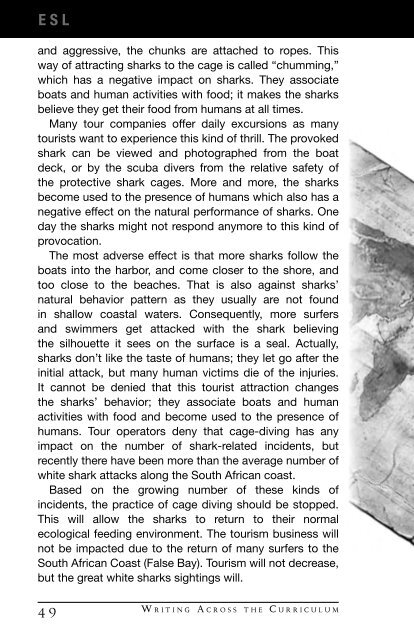2008 - Communication Across the Curriculum (CAC)
2008 - Communication Across the Curriculum (CAC)
2008 - Communication Across the Curriculum (CAC)
Create successful ePaper yourself
Turn your PDF publications into a flip-book with our unique Google optimized e-Paper software.
E S L<br />
and aggressive, <strong>the</strong> chunks are attached to ropes. This<br />
way of attracting sharks to <strong>the</strong> cage is called “chumming,”<br />
which has a negative impact on sharks. They associate<br />
boats and human activities with food; it makes <strong>the</strong> sharks<br />
believe <strong>the</strong>y get <strong>the</strong>ir food from humans at all times.<br />
Many tour companies offer daily excursions as many<br />
tourists want to experience this kind of thrill. The provoked<br />
shark can be viewed and photographed from <strong>the</strong> boat<br />
deck, or by <strong>the</strong> scuba divers from <strong>the</strong> relative safety of<br />
<strong>the</strong> protective shark cages. More and more, <strong>the</strong> sharks<br />
become used to <strong>the</strong> presence of humans which also has a<br />
negative effect on <strong>the</strong> natural performance of sharks. One<br />
day <strong>the</strong> sharks might not respond anymore to this kind of<br />
provocation.<br />
The most adverse effect is that more sharks follow <strong>the</strong><br />
boats into <strong>the</strong> harbor, and come closer to <strong>the</strong> shore, and<br />
too close to <strong>the</strong> beaches. That is also against sharks’<br />
natural behavior pattern as <strong>the</strong>y usually are not found<br />
in shallow coastal waters. Consequently, more surfers<br />
and swimmers get attacked with <strong>the</strong> shark believing<br />
<strong>the</strong> silhouette it sees on <strong>the</strong> surface is a seal. Actually,<br />
sharks don’t like <strong>the</strong> taste of humans; <strong>the</strong>y let go after <strong>the</strong><br />
initial attack, but many human victims die of <strong>the</strong> injuries.<br />
It cannot be denied that this tourist attraction changes<br />
<strong>the</strong> sharks’ behavior; <strong>the</strong>y associate boats and human<br />
activities with food and become used to <strong>the</strong> presence of<br />
humans. Tour operators deny that cage-diving has any<br />
impact on <strong>the</strong> number of shark-related incidents, but<br />
recently <strong>the</strong>re have been more than <strong>the</strong> average number of<br />
white shark attacks along <strong>the</strong> South African coast.<br />
Based on <strong>the</strong> growing number of <strong>the</strong>se kinds of<br />
incidents, <strong>the</strong> practice of cage diving should be stopped.<br />
This will allow <strong>the</strong> sharks to return to <strong>the</strong>ir normal<br />
ecological feeding environment. The tourism business will<br />
not be impacted due to <strong>the</strong> return of many surfers to <strong>the</strong><br />
South African Coast (False Bay). Tourism will not decrease,<br />
but <strong>the</strong> great white sharks sightings will.<br />
4 9<br />
W r i t i n g A c r o s s t h e C u r r i c u l u m






